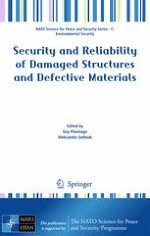2009 | OriginalPaper | Chapter
From Macro to Meso and Nano Material Failure. Quantized Cohesive Model for Fractal Cracks
Author : Michael P. Wnuk*
Published in: Security and Reliability of Damaged Structures and Defective Materials
Publisher: Springer Netherlands
Activate our intelligent search to find suitable subject content or patents.
Select sections of text to find matching patents with Artificial Intelligence. powered by
Select sections of text to find additional relevant content using AI-assisted search. powered by
A discretization procedure for the cohesive model of a fractal crack requires that all pertinent entities describing the influence of the cohesive stress that restrains opening of the crack, such as effective stress intensity factor, the modulus of cohesion, extent of the end zone and the opening displacement within the high-strain region adjacent to the crack tip are re-visited and replaced by certain averages over a finite length referred to as either “unit step growth” or “fracture quantum”. Thus, two novel aspects of the model enter the theory: (1) degree of fractality related to the roughness of the newly created surface, and (2) discrete nature of the propagating crack. Both variables are shown to increase the equilibrium length of the cohesive zone. At the point of incipient fracture this length becomes the characteristic material length parameter L
c
.
Novel properties of the present model provide a better insight and an effective tool to explain multiscale nature of fracture process and the associated transitions from nano- to micro- and macro-levels of material response to deformation and fracture. These multiscale features of any real material appear to be inherent defense mechanisms provided by nature.
As the degree of fractality increases, the characteristic material length is shown to rapidly grow to the levels around three orders of magnitude higher than those predicted for the classic case. Such effect is helpful in explaining an unusual size-sensitivity of fracture testing in materials with cementitious bonding such as concrete and certain types of ceramics, where fractal cracks are commonly observed.
In the limit of vanishing quantum fracture and/or reduced degree of fractality the quantized cohesive model of a fractal crack, as presented here, reduces to the well-known classic models of Dugdale—Barenblatt or to the LEFM or the QFM fracture theories.
